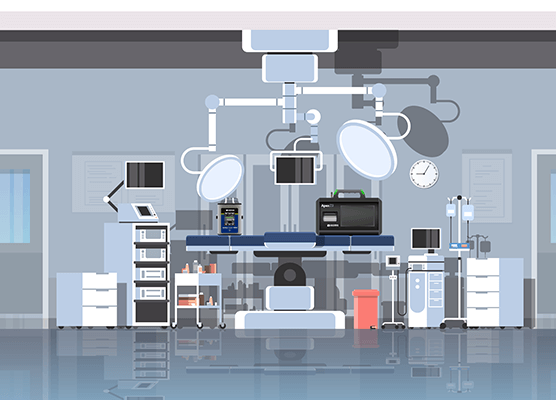-
Your shopping cart is empty!
The Importance of Environmental Monitoring in Healthcare
Wednesday November 5th, 2025
-
0 lượt xem
1️⃣ The Alarming Reality: Healthcare-Associated Infections (HAIs)
Did you know that 1 in every 31 hospitalized patients in the United States is expected to contract a Healthcare-Associated Infection (HAI)?
According to the Centers for Disease Control and Prevention (CDC), nearly 2 billion nosocomial infections occur each year, resulting in over 90,000 deaths and economic losses of up to USD 28–45 million annually.
These numbers are not only financial burdens — they represent real suffering for patients, families, and medical staff.
Fortunately, there’s a practical solution to reduce this risk: Environmental Monitoring.
2️⃣ What Is Environmental Monitoring?
Environmental Monitoring (EM) refers to the process of observing, controlling, and documenting key environmental parameters such as:
- Air and surface cleanliness
- Temperature and humidity
- Differential pressure
- Airflow rate
- Other environmental safety indicators
In the pharmaceutical and cleanroom industries, EM is a mandatory requirement under GMP and ISO Class standards.
However, it also plays a crucial role in hospitals and healthcare facilities to prevent cross-contamination and control HAIs effectively.
3️⃣ Key Environmental Monitoring Factors in Hospitals
Modern hospitals must continuously monitor various environmental parameters to ensure patient safety and infection control.
🌡️ Temperature and Humidity
- Humidity: Must be maintained above 30%; operating rooms (ORs) should stay between 20% – 60%.
→ Improper humidity levels can affect sterilization efficiency, the shelf life of drugs, and increase the risk of wound infections. - Temperature: Should be controlled according to each hospital zone — for example, ICUs and cold storage rooms require tighter temperature control.
🧴 Surface and Equipment Hygiene
Bacteria, dust, and particles can accumulate on frequently touched surfaces.
Regular cleaning and disinfection are therefore integral to EM programs — especially in ORs, ICUs, isolation units, and storage areas.
💨 Airflow and Pressure Control
- Operating Rooms (ORs) use positive pressure systems to prevent contaminated air from entering.
- Quarantine Units use negative pressure systems to keep contaminated air from escaping.
HEPA filtration and airflow monitoring systems help manage airborne contaminants and maintain a clean environment.
4️⃣ Environmental Monitoring Applications in Hospitals
🏥 Operating Rooms (ORs)
- Require the strictest control of humidity, temperature, air pressure, and microbial contamination.
- Positive pressure systems and HEPA filters ensure a sterile airflow and minimize infection risk during surgery.
🧫 Quarantine Units
- Use negative pressure technology to contain infected air.
- HVAC systems must ensure that outgoing air is filtered before being recirculated.
- Continuous monitoring of temperature, humidity, and airflow ensures maximum safety.
❄️ Medicine and Medical Supply Storage
Refrigerators and cold rooms must be temperature-checked at least twice daily to ensure correct storage conditions for drugs and vaccines.
🍽️ Food Service Areas
- Strict temperature control prevents foodborne contamination and cross-infection.
- Temperature monitoring systems help maintain hospital hygiene compliance.
❤️ Intensive Care Units (ICUs)
- Maintain positive pressure and filtered airflow to protect vulnerable patients.
- Medical staff are trained to follow strict gowning and sterile procedures to prevent contamination.
5️⃣ How Do You Know Your Environmental Monitoring System Works?
Key monitoring tools include temperature, humidity, pressure sensors, and particle counters.
Hospitals and healthcare facilities can choose between:
- Continuous Monitoring – ensures real-time tracking and early detection of deviations.
- Periodic Monitoring – suitable for low-risk areas but less precise and responsive.
💡 Ultimately, environmental monitoring saves time, money, and lives — serving as a vital defense against HAIs and their devastating consequences.
6️⃣ Hospital Environmental Monitoring Solutions from Filterfine Vietnam
With extensive experience implementing Environmental Monitoring Systems (EMS) for pharmaceutical plants, hospitals, and cleanrooms, Filterfine Vietnam provides ISO, GMP, and EN 17141–compliant equipment, including:
🔹 Handheld & Fixed Particle Counters
🔹 Air Microbial Samplers (Air Sampler)
🔹 Remote Environmental Monitoring Systems
🔹 Temperature, Humidity & Pressure Sensors with Data Loggers
👉 Filterfine’s comprehensive solutions enable hospitals to proactively control infection risks, ensure patient safety, and meet international audit standards.
📞 Contact Us for Consultation
Filterfine Vietnam – Leading Cleanroom Equipment & Solutions Provider
🌐 Website: https://filterfinevn.com
📧 Email: info@filterfinevn.com
📞 Hotline: 0961 152 844
Tin liên quan
- IN-DEPTH TRAINING ON ISO 14644 CLEAN ROOM STANDARDS WITH LIGHTHOUSE EXPERTS
- SMART MEASUREMENT 4.0: THE NEW ROLE OF MEASUREMENT TECHNOLOGY IN QUALITY ASSURANCE AT THE FACTORY
- [Webinars] LIGHTHOUSE LAUNCHES NEW ENVIRONMENTAL MONITORING SOLUTION System-in-a-Box (SIAB)
- I-PHARBACO CENTRAL PHARMACEUTICAL JOINT STOCK COMPANY
- System in a Box – The All-in-One, Plug-and-Play Solution for Environmental Monitoring











